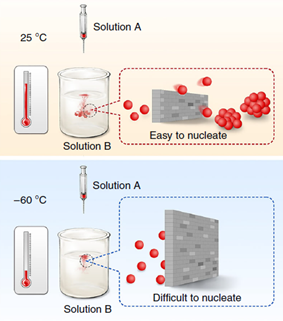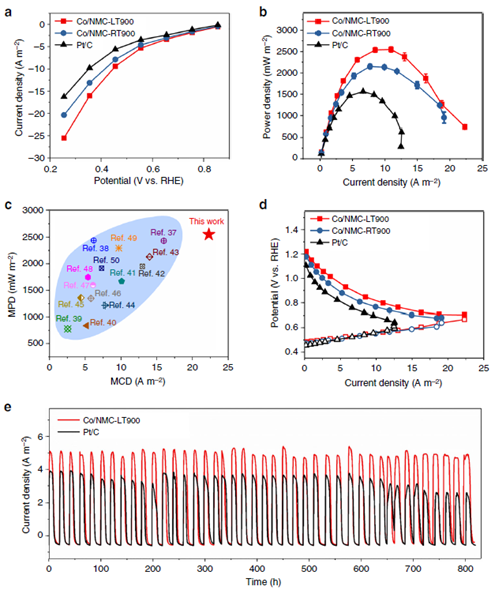Prof. Hui Wu group (School of Materials Science and Engineering, Tsinghua University), in collaboration with Prof. Xiaoyuan Zhang group (School of Environment, Tsinghua University), Li-Min Liu group (School of Physics, Beihang University) and Binghui Ge (Institute of Physical Science and Information Technology, Anhui University) recently published a paper entitled “-60°C solution synthesis of atomically dispersed cobalt electrocatalyst with superior performance” on Nature Communication (2019) 10:606. In this research, they pushed the temperature of numerous solution synthesis to a record-low temperature of -60°C, and they demonstrated that atomically dispersed Co, Fe, Ag and Pt catalysts can be synthesized in solution without adding stabilizer or surfactant at such low temperatures, as illustrated in Figure 1.

Figure 1 Schematic diagram of nucleation regulation in solution synthesis at -60 oC and room temperature
The facile synthesis of single atom catalysts (SACs) or atomically dispersed catalysts have attracted more and more attention. Wet-chemistry methods have been applied to synthesize metal SACs, and one significant challenge is to avoid the aggregation of atom in solution synthesis to form nuclei and nanoparticles. According to the nucleation theory, the nuclei formation and growth represent the first stages undertaken by the products species, stepping over an energy barrier to aggregate as precipitate. An interesting and important question we considered is how different the products will be when solution reactions run at lower and lower temperatures.
Several novel features are shown in this work:
1. Thermodynamic and kinetic control to obtain atomically dispersed catalysts in solution. By using water/alcohol mixed solvent system to provide low freezing-point of the reaction system, they successfully conducted a serious of solution synthesis at an ultralow temperature of -60°C. Taking advantages of significant higher energy barrier and sluggish nucleation rate at such low temperatures, stable atomically dispersed metals in solution without nuclei formation was achieved. The low temperature synthesis provides a general and fundamental strategy to synthesis single atom catalysts.
2. Superior performance for ORR electrocatalysis. Single atom Co catalysts on nitrogen-doped mesoporous carbon (NMC) substrates can be synthesized at -60°C, and such materials presented superior catalytic activities and stabilities in both alkaline and neutral electrolytes, superior to the state-of-the-art commercial platinum/carbon catalyst and other previously reported non-precious catalysts. The onset potential and half-wave potential values of our Co catalysts were 62 mV and 39 mV more positive than that of Pt/C catalyst in alkaline electrolyte.
3. Superior performance in full fuel cell devices. They further applied the atomically dispersed Co catalysts in practical microbial fuel cells (MFCs) devices, as shown in Figure 2. The cell outputs a maximum power density of 2550 ± 60 mW m-2, with no current drop operated for 820 h. The MFCs with atomically dispersed Co catalysts air-cathodes can treat wastewater and simultaneously generate high electric power. The novel low-temperature solution synthesis not only provide a new generalized method to redesign reaction kinetics and thermodynamics by controlling the nuclei formation and growth behavior in wet chemistry process, but also open up new possibilities for the nucleation understanding in solution reactions and the fabrication of high-performance catalyst materials using conventional solution chemical method.

Figure 2 Microbial fuel cell performance of atomically dispersed metal catalysts
Prof. Hui Wu group in School of Materials Science and Engineering, Tsinghua University, has long engaged in the large-scale preparations of low-dimensional functional nanomaterials and their applications. Prof. Xiaoyuan Zhang group in School of Environment, Tsinghua University, has long engaged in water and wastewater treatment, energy and resource recovery from wastewater. Prof. Hui Wu, Li-Min Liu, Xiaoyuan Zhang and Binghui Ge are the corresponding authors, Dr. Kai Huang, Le Zhang and Ting Xu are the co-first authors. This research is funded by National Science Foundation, National Basic Research and Postdoctoral Science Foundation, and can be viewed by https://www.nature.com/articles/s41467-019-08484-8


